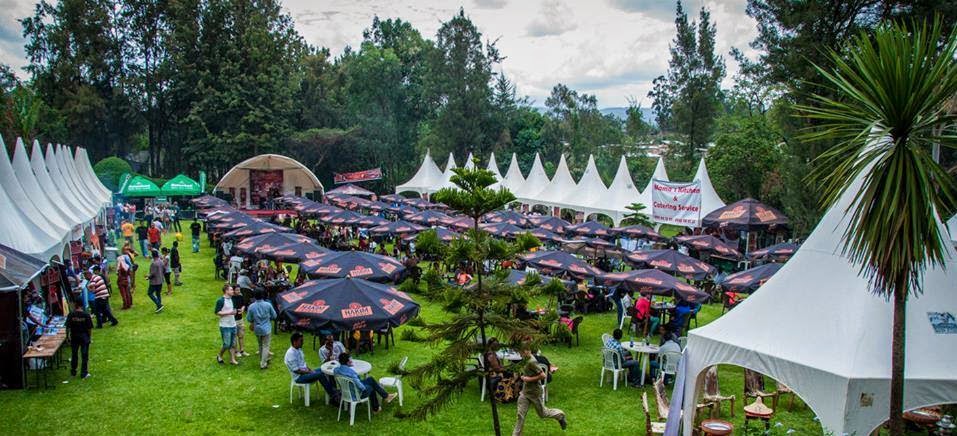Reviewing Taste of Addis
The six of us and a little boy made it to the event on october 25th, 2014. From the main road, finding Tropical Gardens was not that hard. Once we arrived at Elephant Cafe, we asked strangers for directions. Crossing the road we walked for a while in what seemed to be a quiet residential neighbourhood. There were no posted direction guidance to Tropical Gardens. When we saw a group of caucassians walking ahead of us we decided to tail them. I mean that's where they're heading to, right? Organizers of this event pleeease do something about directions, may be put up a few signs. And so we were there around 3pm.
At the enterance we paid an enterance fee of 50Birr each. Once inside, the first thing we saw was a paid children's play ground. Walking past, we came across the first food stands. And walking down the stairs there was a lot more.
Image borrowed from Taste of Addis Facebook page
It was a very hot day and all the seats under the umbrellas were taken. We managed to find a spot under the shadow of a tree. Although it was cool and refreshing to sit on the grass, we would have preferred to have had a picnic blanket with us. By then we were all famished so we went to get something to eat and drink. That day the price cap per dish was 50Birr.
Our first stop was Burger Shack but we were told because power is out they couldn't make burgers or fries. We looked around and the only place that was putting out warm food was Santorini, the greek restaurant. From there we bought a couple of the moussakas (which btw turned out to be AMAZING) and souvlakis. We found the beef in the souvlakis to be very chewy and lacking in flavor. But I have to say we ate it all since we were famished.
The power kept going out. And so our choices were limited. To get drinks we stopped at Ambo's stall and bought a bottle of Flavored Ambo. We were offered a five minute foot massage for each bottle bought, my cousin accepted the offer (oh and yes she enjoyed it very much). The rest of us moved on to the tej stand, where a disposible glass of tej cost 30 Birr. For me, this could be because it had been a while since I last had any tej, but I thought it was a little too sweet.
When we passed by, the Yemeni stand caught my eyes. I hadn't tried Yemeni cuisine before. So we got a plate of what I now assume was Mundi, marinated lamb with rice and spicy sauce on the side. The lamb was well seasoned and very tender. Inspite of the sauce being a little to hot, the dish was delicious.
The music was constantly on and off. So the next time it was on (which meant that the power's back), the younger ones in our group went to get Burger Shack french fries and came back with two plates which cost 30 Birr each. But of course we all had to taste. I have to admit, having heard so much about this place, I had higher expectations. The fries were crunchy on the outside, as they should be, but too cold on the inside as if they were still frozen. We had to give them a break though, it must have been tough enough to put out anything with power outage every few minutes.
We didn't have much room for desert anymore, but we had to try the smoothies we saw on our way in. The guava (perhaps mixed with mango) smothey was rather impressive and very refreshing. Another positive from this event was that the bathrooms were tidy and had sufficient supply of toilet paper.
Unfortunately verything comes to an end and we had to leave. On our exit, we came to realize that the party was just starting. The crowd was getting thicker by the minute and it was almost impossible to find a parking spot by 6 p.m. I was genuinely surprised by the huge turnout and for a moment considered staying longer and to enjoy the evening. We had heard there'd be a concert. As we finally left, we decided that the next time we attend this event, there won't be any underage children in the mix :)



